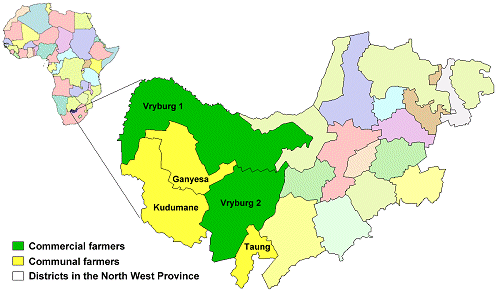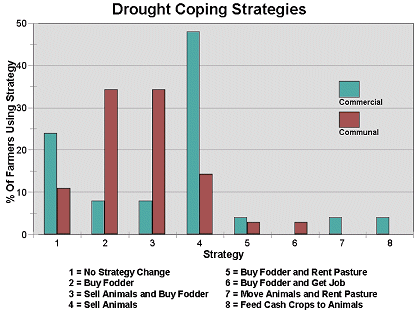|
Farm Management
Drought is a recurring phenomenon in southern Africa, and farmers must continually cope with high
rainfall variability. Therefore, they must be flexible, responsive, and have a wide range of drought
mitigation strategies. Responses to minimize the effects of short- and long-term drought differ depending
upon farmer type: commercial farmers tend to decrease herd size in order to maintain a higher average
weight on each animal, and communal farmers tend to maintain their herd size, at the expense of lower
weight per animal. This study explored drought management strategies under drought conditions, use of
climate forecasts, and needed information about climate forecasts including the value of added
information developed from ecological modeling and economic modeling, in the five western districts of
the North-West Province: Vryburg 1, Vryburg 2, Ganyesa, Kudumane, and Taung (Figure 1).

Figure 1. The five western districts of the North-West Province: Vryburg 1,
Vryburg 2, Ganyesa, Kudumane, and Taung.
In the two Vryburg districts, commercial farmers own large widely-spaced, western-style farms, typically
greater than 2500 ha, that are mainly used for cattle production. Most farmers rotate animals using the
camp system to maximize grass production. This consists of keeping animals in pastures for a limited
time to control grazing and allow for higher grass production. Recent economic hardships and
decreasing farm profits, has resulted in an increasing tendency for farmers to absorb neighboring farms in order to increase herd sizes and, consequently, their profit margin. Other farmers diversify by providing products for specific markets such as specialized cattle breeds, production of game animals, operation of hunting lodges, or selective breeding of foreign animals. In general, commercial farms are run for profit, and support a small nuclear family and many permanent workers.
The three other districts, Ganyesa, Kudumane, and Taung, are communal areas that were formed as part
of the former Bophuthatswana Homeland. Homelands, formed in the 1950s during the nation's apartheid
rule, were reincorporated into the Republic of South Africa with the abolishment of apartheid in 1994. In
these districts, animals are individually owned at the household level but graze on communal pasture
lands with poorly defined boundaries. Grazing rights are controlled by the village chief, village council,
or by complex social norms. Typically, communal farmers are subsistence level farmers who support a
small number of people in their nuclear and extended family.
Drought is a recurrent phenomena in the southern Kalahari, and the certainty of seasonal variability in
rainfall means that farmers have devised diverse livestock management strategies to minimize anticipated
effects of likely future drought conditions. One drought year often follows another, and occasionally
there will be several years of sequential drought. Most commercial farmers think they can cope with
droughts lasting one to three years, and more communal farmers report that any drought is serious for
their survival (Table 1).
Table 1. Number of years of anticipated drought survival.
Farmers Responding |
How Many Years of Drought
Can You Cope With?
Percent of respondents
(Number of respondents) |
| 0 |
1 |
2 |
3 |
4 |
 |
Commercial Farmers
(n = 25) |
4
(1) |
40
(10) |
32
(8) |
16
(4) |
8
(2) |
Communal Farmers
(n = 35) |
37
(13) |
34
(12) |
23
(8) |
6
(2) |
0
(0) |
Total respondents
(n = 60) |
23
(14) |
37
(22) |
27
(16) |
10
(6) |
3
(2) |
Drought coping strategies in the five districts of the study area include maintaining a lower than optimal
herd size in order to ensure adequate feed, decreasing herd size, buying feed, or obtaining grazing rights
in additional pastureland (Figure 2).
 Figure 2. Coping strategies, all farmers.
Figure 2. Coping strategies, all farmers.
Over twice as many commercial farmers as communal farmers report that they do not need to make size
or maintenance adjustments to their animal herds in the face of drought. However, the coping strategy of
choice among commercial farmers who feel the need to alleviate drought-related stresses on their herds is
to reduce herd size by selling animals. Communal farmers, by comparison, report having fewer coping
strategies, and tend to buy either fodder or sell only enough animals to get money for maintaining the rest
of their herd. Thus communal farmers have strategies intended to keep as many animals as possible.
Reasons for differences in commercial and communal drought management strategies
A number of factors can be used to explain the reasons for different drought strategies utilized by
commercial and communal farmers. The first factor is that of differing goals. For example, the South
African Department of Agriculture views commercial farmers as successful animal producers who make
optimal use of their available resources. Communal farmers, on the other hand, are considered to over-graze pastures, degrade the environment, and practice methods of inefficient animal production. These
ideas are based on assumptions that communal farmers tend to keep animals as a measure of wealth and
for social status. This research shows reality to be somewhere between these stereotypical views.
Regardless of a farmer's coping strategy or amount of available resources, prior knowledge of
approaching drought is potentially advantageous for all farmers. For example, with advance knowledge
of impending drought, farmers can purchase additional fodder, make advance arrangements for grazing
on additional pastureland, or sell animals while market prices are still high and their animals are in good
condition. To what extent do ranchers use forecasts and how do they or how might they affect their
management strategies?
Use of Forecasts in the Livestock Sector
In addition to providing more strategies for drought mitigation, advanced and timely drought information
potentially helps farmers develop better drought coping strategies. Farmers using climatic forecast
information to implement drought plans prior to its event act in a prescriptive rather than reactive
manner. Sixty percent of farmers in the western part of the North-West Province perceive forecasts being
not at all or only somewhat valuable, and 40% perceive forecasts as being valuable or very valuable
(Table 2).
Table 2. Perceived value of climate forecasts.
|
Farmers responding |
Value of Climatic Forecasts
Percent of respondents (Number of respondents) |
|
Not at all |
Somewhat |
Valuable |
Very |
Total |
 |
| Commercial
|
24
(6) |
56
(14) |
4
(1) |
16
(4) |
100
(25) |
| Communal |
31
(11) |
14
(5) |
37
(13) |
17
(6) |
100
(35) |
Total Respondents
(n=60) |
28
(17) |
32
(19) |
23
(14) |
17
(10) |
100
(60) |
However, commercial and communal farmers have different perceptions of the value of
forecast information. Disaggregated data shows that 80% of commercial farmers reported forecasts as
being not at all valuable or only somewhat valuable, and 54% of communal farmers reported forecasts as
being valuable to very valuable. Thus, more communal than commercial farmers value climatic
forecasts. Farmers were asked how they perceived forecast accuracy and if they made or would make herd
management decisions based on climatic forecast information (Table 3).
Table 3. All farmers: perceptions of forecast accuracy and use in decision-making.
|
Combined - All farmers |
Accuracy of forecasts
Percent of respondents
(Number of respondents) |
| Decisions made because of
forecasts in 1999 ? |
Not
Accurate |
Somewhat
Accurate |
Are
Accurate |
 |
No 71
(43) |
33
(20) |
25
(15) |
13
(8) |
Yes 29
(17) |
2
(1) |
17
(10) |
10
(6) |
Total respondents
(n = 60) |
35
(21) |
42
(25) |
23
(14) |
Responses show that 23% of all
farmers believe that forecasts are accurate, and only 29% said they made or would make management
decisions for the 1999-2000 growing season based on climatic forecasts. There is not a very high
correlation between the percent of farmers who made decisions based on forecasts (29%) and farmers who say they believe forecasts are accurate (10%). The
majority of farmers do not think forecasts are accurate, implying that farmers who believe that forecasts
are only somewhat accurate, or not at all accurate, make up most of the farmers making management
decisions based on forecasts.
Reference
Hudson, J. 2001 "Responses to Climate Variability in the Livestock Sector in the North-West Province,
South Africa." MA Thesis, Colorado State University, Fort Collins, CO (in progress)
|